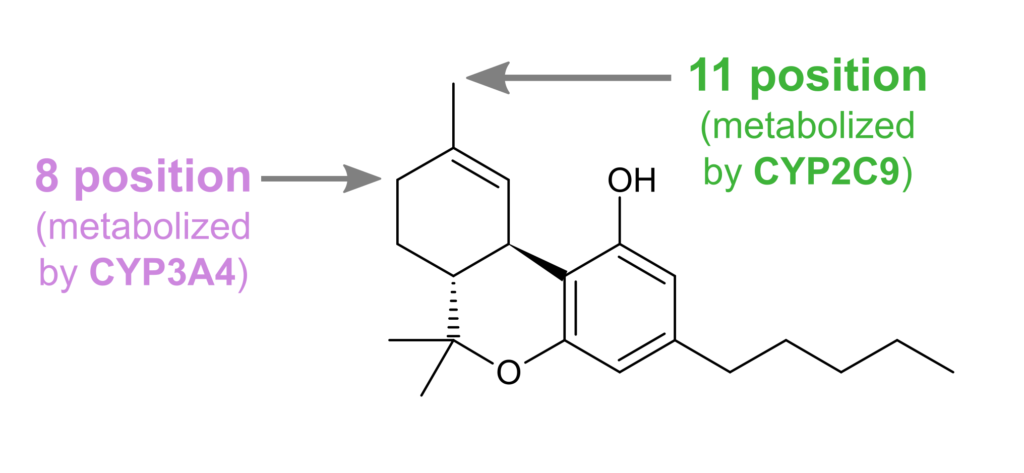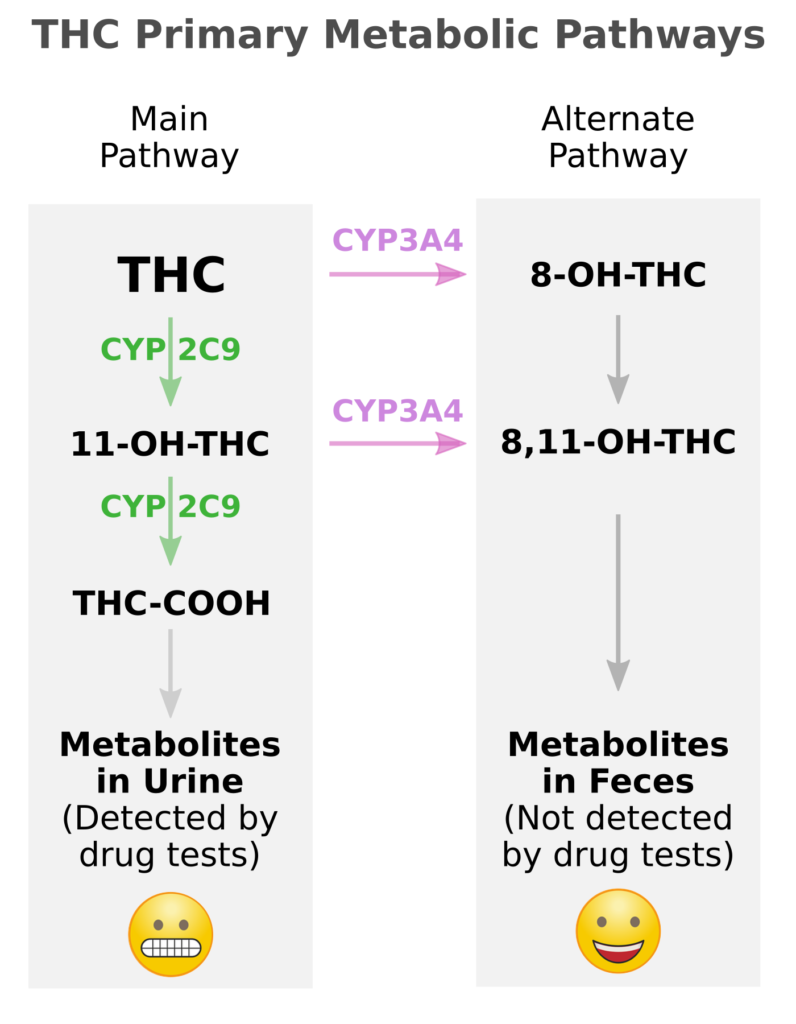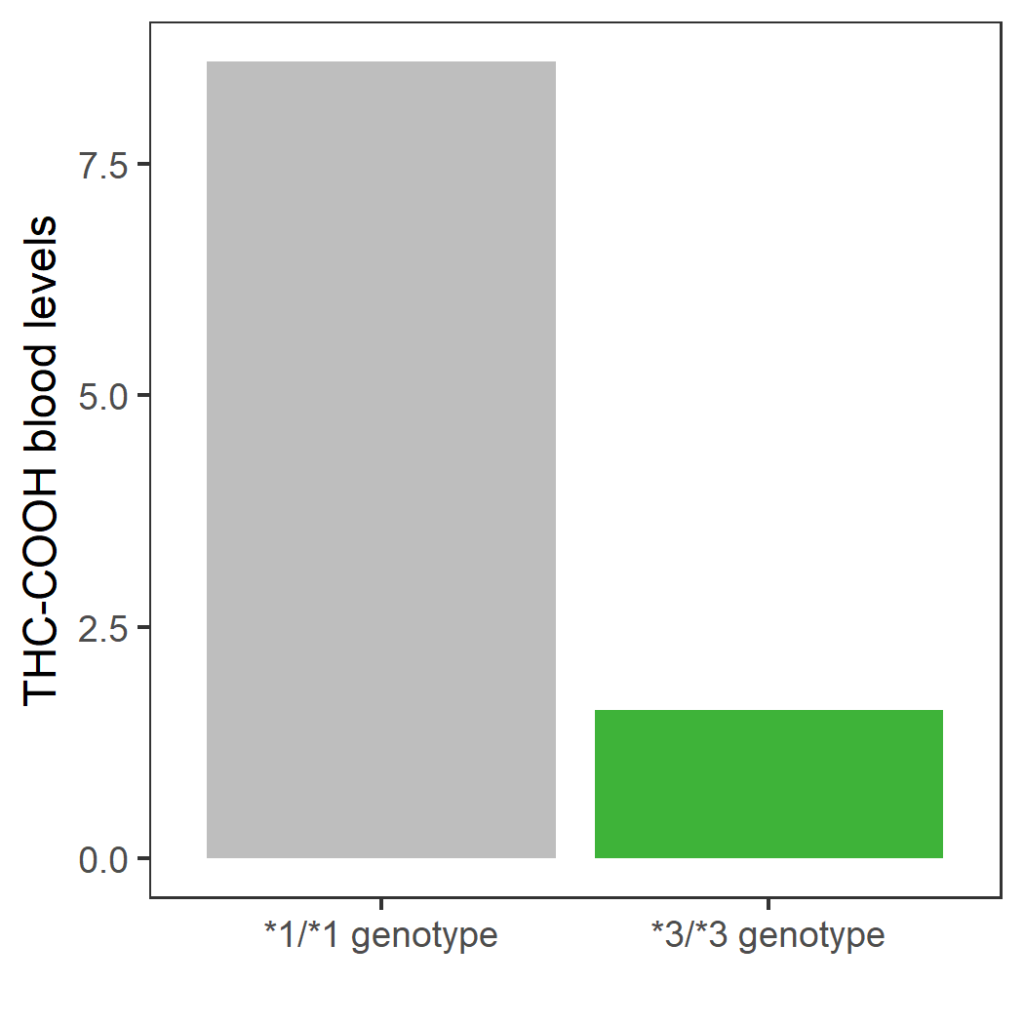The CYP2C9 and CYP3A4 enzymes determine which metabolic pathway THC goes down. Here is how to optimize them to prevent detectable urine metabolites.
THC (and most other drugs) undergo metabolism that is mediated by the aptly named drug metabolizing enzymes. This is your body’s natural way of detoxing THC and removing it from your body. But they don’t do it in the most beneficial way – they create metabolites that are excreted into your urine and are detected in urine drug tests.
There are ways to manipulate these enzymes through either raising their levels (called induction) or inhibiting their activity. By doing this, we can optimize the metabolism of THC and favor pathways that don’t lead to detectable urine metabolites.
Metabolic Pathways for THC Detox
There are many different metabolic pathways for THC! However, most of them represent such a small fraction of where THC goes that they are not particularly important. For today, I will present just the two most relevant pathways.
Which pathway THC goes down is determined by which site on the THC molecule is metabolized. There are two primary sites where metabolism occurs. One is the carbon at the “8” position and the other is the carbon at the “11” position.

Here is the most important thing to know: the initial metabolism at each of the sites is catalyzed by a different enzyme. The 11 position is metabolized almost entirely by an enzyme called CYP2C9 and the 8 position almost entirely by a related enzyme called CYP3A4.
Other enzymes are involved downstream in these pathways, but they can’t act without CYP2C9 or CYP3A4 first adding a hydroxy (hydrogen + oxygen) group to the molecule.

Look at the figure above. I call the pathway on the left the “main” pathway even though only a small fraction of THC actually makes it all the way to the end. This pathway is important for THC detox because:
- It includes the 11-OH-THC metabolite, a potent psychoactive metabolite
- It ends with metabolites that are excreted into the urine and detected by urine drug tests
The reality is that the majority of THC ends up going down alternate metabolic pathways. The most important alternate pathway is shown on the right. THC can be hydroxylated at the 8 position, leading to this alternate pathway.
Even the 11-OH-THC metabolite is not locked into the main pathway. A significant amount of 8,11-dihydroxy-THC was formed after administration of the 11-OH-THC metabolite to humans (1972 study). This shows that 11-OH-THC can still be diverted away from the main metabolic pathway. However, once 11-OH-THC is converted to THC-COOH, it is locked into the main metabolic pathway.
In case you didn’t catch on with the emojis, THC staying on the main pathway is bad for detox. Promoting the alternate pathway is good for detox, since this reduces levels of psychoactive molecules (THC & 11-OH-THC) while also reducing urine levels of detectable metabolites.
Let’s get back to the CYP enzymes. You will notice that the first two steps in the main pathway are mediated by CYP2C9 and both steps that lead to the alternate pathway are mediated by CYP3A4. Here are some lab studies that support this conclusion :
- Out of 10 expressed CYP isoforms, only CYP2C9 had significant 11 hydroxylation activity (2007 study)
- Expressed CYP3A4 had significant 7 and 8 hydroxylation activity (2007 study)
- 11-OH-THC formation was almost completely inhibited by sulfaphenazole (a CYP2C9 inhibitor), but there was little inhibition with the CYP3A4 inhibitor ketoconazole (2005 study & 2007 study)
Effects of CYP3A4 Inducers
Based on the lab studies described above, we can be pretty sure that CYP3A4 activity is a good thing for THC detox. But a common problem is that once something is tested in humans, the results contradict the lab studies. Well we are in luck, because a human study has already been performed, and the results fit perfectly with the lab data.
There are drugs called enzyme inducers. They stimulate your body to produce more of a specific enzyme. This process takes several days, since creating more enzyme takes time.
Rifampicin is a drug which causes your body to produce more of the CYP3A4 enzyme (i.e. it is a CYP3A4 inducer). A 2013 study evaluated the effect of a 9 day treatment with rifampicin on the pharmacokinetics of Sativex, a THC:CBD oral spray.
Rifampicin treatment reduced average THC levels by 24%. This is not much considering that it can reduce levels of some drugs by much more. Why didn’t rifampicin have such a strong effect on THC? Possibly because THC is a drug exhibiting “flow-limited clearance”. In other words, nearly all THC passing through the liver is metabolized, so increasing enzyme levels has little effect.
Effects on 11-OH-THC were much more dramatic. CYP3A4 induction resulted in a 7.8-fold reduction in 11-OH-THC levels. Half-life was also reduced by 2.4-fold.

Two things can explain this dramatic reduction in 11-OH-THC levels and they probably both play a role:
- Reduced formation of 11-OH-THC. With CYP3A4 induced, a greater fraction of THC is metabolized to alternate pathways, such as 8-OH-THC, instead of 11-OH-THC.
- Increased clearance of 11-OH-THC. With CYP3A4 induced, 11-OH-THC is eliminated faster, likely to alternate pathways, such as 8,11-dihydroxy-THC, instead of THC-COOH.
Although these results are quite dramatic, one of the downsides of CYP3A4 inducers is that they act slowly. Unlike inhibition, which is basically instant, enzyme induction takes time. It may take several days to see significant induction and maximal induction can take over a week.
Effects of CYP2C9 Inhibitors
Like with CYP3A4 inducers, CYP2C9 inhibitors should yield excellent results for THC detox, but we need the clinical validation (i.e. human studies). Unfortunately, no clinical studies on THC metabolism have yet been performed with a selective CYP2C9 inhibitor.
However, we are in luck, because we know the effect of reduced CYP2C9 activity due to a genetic variant of this enzyme which metabolizes THC slower. This CYP2C9*3 variant metabolizes THC at 27% of the rate of the more common *1 version of the enzyme (2005 study).
So not surprisingly, people with the *3/*3 genotype had significantly slower THC metabolism (2009 study). Average THC levels were 3.1 fold higher and half-life was 2.9-fold longer.

Sure, higher THC levels are bad, but let’s take a look at the THC-COOH metabolite. 24 hours after a THC dose, average THC-COOH levels were 5.4-fold lower in *3/*3 subjects. This result shows that the amount of THC-COOH formed is directly related to the activity of the CYP2C9 enzyme. It also provides clinical validation that selective CYP2C9 inhibitors will significantly reduce THC-COOH levels (and thus downstream metabolites and their urine levels as well).
CYP2C9 inhibition is nearly instant, and thus you can expect more immediate results compared to a CYP3A4 inducer. However, CYP2C9 inhibitors have the disadvantage of reducing THC clearance (even while reducing urine metabolite levels). This means that the effect of a CYP2C9 inhibitor is not permanent. Once you stop taking it, levels of THC-COOH and downstream metabolites will be replenished as CYP2C9 activity is restored.
Synergism of a CYP3A4 Inducer + CYP2C9 Inhibitor
Individually, either a CYP3A4 inducer or a CYP2C9 inhibitor can help with THC detox in a unique way. However, each also has its disadvantages.
So what is the solution? Combine them together and each molecule can cancel out the negatives of the other. For example:
- A CYP2C9 inhibitor will provide an immediate effect while the CYP3A4 inducer is taking its time to raise enzyme levels.
- A CYP3A4 inducer will increase THC clearance that is slowed by a CYP2C9 inhibitor
This combination will result in synergistic activity. The CYP2C9 inhibitor will block formation of 11-OH-THC and THC-COOH, while the CYP3A4 inducer is simultaneously increasing clearance of THC and 11-OH-THC to alternate pathways.
The end result is a more rapid detox of the psychoactive THC and 11-OH-THC molecules, while simultaneously decreasing urine metabolite levels.
Development of CannaPass THC Metabolism Optimizer
Manipulating drug metabolizing enzymes is one of the most powerful ways to achieve THC detox. But how can you actually do this at home?
There are prescription medications that potently inhibit CYP2C9 and induce CYP3A4. But I can’t recommend these as most people won’t have easy access to them.
I searched for dietary supplements that have these activities. Although there are many that have these activities in lab tests, few have any clinical validation (i.e. they haven’t been adequately tested in humans).
I finally settled on a few that were clinically validated, but then I ran into another problem. The commercially available (e.g. at drug stores/GNC/Amazon and the like) herbal extracts were not standardized to the right molecules. There is typically only one molecule in each herb that has the desired activity. The companies that make the supplements do not report how much of that molecule is there, or when they do, it is extremely low.
I finally realized that there was nothing that people could buy off the shelf that would consistently work. Even if the same herbs are available, they won’t be the right extracts with the right molecules at the right dose. That is why I developed my own formulation, specifically designed and manufactured to manipulate CYP enzymes for THC detox: CannaPass THC Metabolism Optimizer – 1 Week Detox.
[A word of caution: CYP enzymes metabolize many other drugs besides THC. If you are taking any medications, you should not try CannaPass Detox without running it by your doctor and/or pharmacist. Just ask them if your medications will interact with a CYP3A4 inducer or a CYP2C9 inhibitor.]

